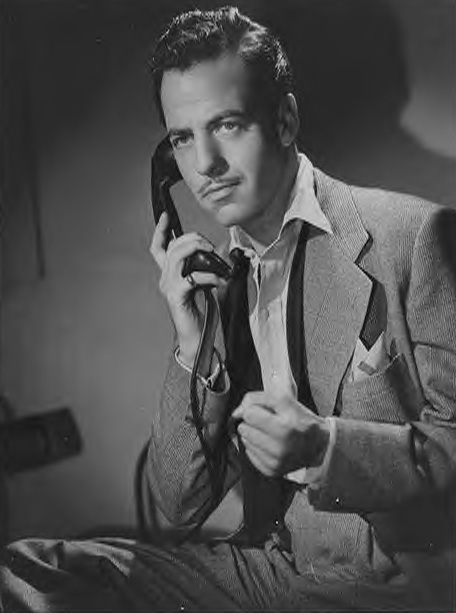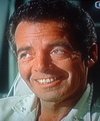Phillip Marlow: radio detective
Streeter Click
Marlowe, the educated, middle-class and cynical LA-based private detective, created by Raymond Chandler, came to radio on 17 June 1947. "The Adventures of Philip Marlowe," starring Van Heflin, was a summer replacement for "The Bob Hope Show." Pepsodent, of course, sponsored the run on NBC that ended 9 September 1947.

On 26 September 1948, "The Adventures of Philip Marlowe" returned to radio on CBS, staying until 15 September 1951. The CBS version starred bassy-voiced, Gerald Mohr, who was widely familiar to audiences. He singled, doubled and even tripled, a few times, on a wide range of shows, including "Our Miss Brooks." In the 1950s, he made frequent appearances on the televised version of "Perry Mason," starring Raymond Burr, and excelled at middle-aged rummy-eyed characters, especially shysters.
Marlowe, the private detective as social philosopher, faces, what Todd McCarthy, terms a "specifically Southern California brand of crime." Wallowing in sleaze and disillusionment, the fictional crime of Los Angeles enables the crushing of dreams by corruption, hypocrisy and cover-up. As always, the expression of a sub-culture, Los Angeles, reflects the core of its infra-structure, entertainment.
James Ellroy, "LA Confidential" and "The Black Dahlia," commands the genre, today. Raymond Chandler, "Lady in the Lake" and "The Long Goodbye," defies time stamping. Both Chandler and Ellroy convey a hard-bitten wrath, angry at the expropriation of a soul for the gain of another.
Chandler wasn't pleased with the radio portrayal of Marlowe. The principled philosophy was lost and heavy-handiness emphasized. Marlowe, as Karl Marx, pined for social justice and loathed exploitation.
Mohr was preferred to Heflin. "A voice like Gerald Mohr's, wrote Chandler to scripter [Gene] Levitt, at least packed personality." Heflin, an early choice to play "Lieutenant Columbo," on television, was superb on screen and mediocre on radio. If Robert Mitchum was the consummate Philip Marlowe, especially on the screen, Mohr was second by a vowel.
Mohr (1914-1968) ostensibly resembled Humphrey Bogart (1899-1
(1899-1 957). A willowy 6' 2", Mohr towered over the 5' 7", frail Bogart. A physical similarity is a stretch. A smooth, heavy voice: a natural, supposedly, also distanced Mohr from Bogart (left). On radio, Mohr played tough guys, effectively; on the screen, television or motion picture, he was most effectively cast as the fellow, with lots of talent, who preferred boozing, gaming and semi-successful womanizing. Bogart, as, say, de Niro, portrayed any character well, in any medium, as long as that character reflected an element of himself.
957). A willowy 6' 2", Mohr towered over the 5' 7", frail Bogart. A physical similarity is a stretch. A smooth, heavy voice: a natural, supposedly, also distanced Mohr from Bogart (left). On radio, Mohr played tough guys, effectively; on the screen, television or motion picture, he was most effectively cast as the fellow, with lots of talent, who preferred boozing, gaming and semi-successful womanizing. Bogart, as, say, de Niro, portrayed any character well, in any medium, as long as that character reflected an element of himself.
Both actors had privileged backgrounds. Bogart was the son of a prominent New York City surgeon, his mother was a magazine illustrator and he went to the Trinity School. Mohr was raised by his mother, Henrietta Noustadt, a Viennese singer (sic), and attended the Dwight School.
A mellifluous voice was all important in early radio. In the early 1930s, Mohr was a staff announcer at CBS, where he came to the attention of Orson Welles. "The Mercury Theatre," lead by Welles, was the network high-culture response to "Bergen and McCarthy," on NBC. "The Mercury Theatre," as John Houseman said, had almost no budget. Vocal quality and budgetary considerations likely motivated Welles to give Mohr his first radio acting roles.
Radio was his medium. In the 1940s, Mohr was the drama equivalent of Frank Nelson, on "The Jack Benny Show": ever present. In 1950, "Radio and Television Life" magazine named Gerald Mohr the Best Male Actor on Radio.
"The Adventures of Philip Marlowe" were hard-boiled radio. Still, most detective shows, of the late 1940s, were less driven by story than Marlowe. "Sam Spade," starring Howard Duff, rode on his charm. "Richard Diamond" was light, even flippant, befitting both the star, Dick Powell, who always managed to get a song in at the end of the show, and the creator and writer, Blake Edwards. "Boston Blackie" was all silliness between the commercials.
As rough and raw as Marlowe was portrayed, the show wasn't gruesome. There was an implicit streak of sophistication, which other shows of the genre lack. "Broadway Is My Beat" is crass, even by current standards, and gruesome for the time. The vocal class of Gerald Mohr infected every word, no matter the story line or action, and ensured the image of Marlowe, as a modern, urban cowboy hero, was conveyed and noted.
The NBC and CBS series both began with "Red Wind," and it's the best episode of each run. The Mohr version is better. Mohr's more at ease on radio, and more practiced than Heflin.
Click here to listen, now, to "Red Wind," starring Gerald Mohr, as it was broadcast by CBS on Sunday, 26 September 1948.
Sources
-----------
John Dunning (1998), "On the Air: the encyclopedia of old-time radio," is published by Oxford University Press. P. 12.
Todd McCarthy (2006), "De Palma's Pale Noir," a review, in weekly Variety, 4-10 September. P. 23.
Corrections, additional information and suggestions welcome and appreciated. Click to e-mail the editor.
Click here for more Old Time Radio shows.
Streeter Click is editor of GrubStreet.ca.
- Courtney Love Writes
- Larry Lujack
- The Cute Beatle
- Dick Summer Top 40
- Mission
- Police Drama of 1950s
- Grub Street Philosophy: 1
Click above to tell a friend about this article.
Recommended
- David Simmonds
- Hockey Poetry
- Helping Pick a VP
- Shamrock Strategy

- Sjef Frenken
- Serving Dogs and Cats
- La Vie en Rose
- Of Exes and Owes

- Jennifer Flaten
- Wisconsin Peaches
- Mellow Out
- Library Books

- M Alan Roberts
- Life is Easy
- Lies and Fear
- Man Hood

Recommended
- Matt Seinberg
- KISS of Death
- Pilots of the Airwaves
- Spies Like Us

- Streeter Click
- Early Tom Baroni
- Why Grub Street?
- Content Submission

- JR Hafer
- Scott Muni
- Alison Steele
- Tell Me All About You

Recommended
- AJ Robinson
- The Hard Truth
- A Step Down
- A Man and His Dog

- M Adam Roberts
- Dream On
- Is She the One?
- The Builder

- Ricardo Teixeira
- Monkey Business
- Harmony
- There is a Light




